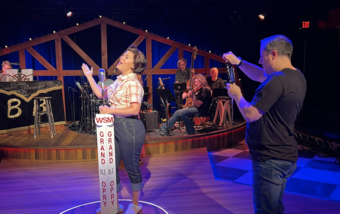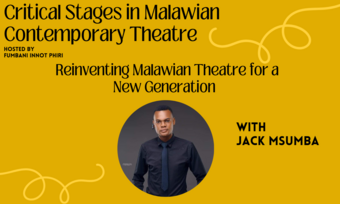The Galaxy's Guide to Digital Media
The Dying Dinosaur—E-Blasts
This is the second post in a series exploring the role of digital media in the theatre realm. Find the full series here.
I want you to take a moment to think about the first moments of your morning routine. Walk through it in your mind.
Here is mine: Every morning I wake up and reach for my smartphone. If it has any juice left from my late night pinning spree, I do my check-ins. Email. Facebook. Twitter. Pinterest.
I open my email. Mostly from organizations and companies I’ve signed up for intentionally or unintentionally from purchasing a product or ticket. Gaaaaawd! There are just so many of them. Maybe I will keep one or two if it’s from something I am personally invested in, my mother, or my bank balance, but everything else goes into the trash.
I go to Facebook and Twitter. I scroll through statuses, check out pages, profiles, pictures, kitten videos, the greatest memes and hashtags invented overnight, retweet articles, commenting, participating. I engage. I still haven’t even left my bed.
And, I know I am not alone in this.
This begs the question: are emails/e-blasts still effective? Are we invading our patron’s inboxes so much that they don’t even open the email? Or is it possible that email has just become too archaic or dare I say boring for marketing purposes? Do emails engage our patrons in quality interaction? I don’t send an email to my friends anymore. I send them a Facebook message or text.
Now, you may scoff, “She doesn’t know what it was like before computers. She’s too young.” I may be young (if thirty is young), but I ain’t no spring chicken. When I was in high school, classrooms were not outfitted with computers. At home, we had ICQ and AIM, and we rocked them out—after school and after homework. Forget texting, I still passed notes my senior year. No one I knew had a personal computer/laptop/desktop at the age of seventeen. You were lucky if your family had one for the whole family. I thought I was hot shit for having my own yahoo email account.
How did we go from thinking we were hot shit for forwarding an email version of chain mail to Instagram where we point, shoot, and share what we had for dinner from a device we hold in our hand?
I am the graduating class of 2000. This was only thirteen years—a hot minute, my friends—ago. My entire life, we teetered on the edge of old school and technology. Just a before this, CD players were tape decks which replaced 8-tracks and then the video killed the radio star. The cusp is a cool place to live; we live the innovation.
How does this affect marketing for the arts?
Email can’t and shouldn’t be your only source of communication with your audience. I’m not suggesting we throw it away either. At least for now. Where email lacks, social media provides a higher level of micro-customer service experience, provides transparency to our process, and develops brand loyalty. So, if someone deletes your well crafted, beautifully designed e-blast, you can hyper-engage them using your social media before they even get out of bed and recover that loyalty. And, the upshot is you can also tell all their friends about it.
Where do we go from here?
In an age where 3D printers (replicators much?) make toys from your child’s crayon drawing, and “Explorer Editions” of Google’s Project Glass are distributed to developers for $1500 a pop this year (Geordi’s visors?), it’s only a matter of time before emails are a thing of the past. Think of what we could do to engage our patrons with our brand and our art! But, until then, as artists and arts administration nerds we need keep pushing forward and live the innovation. Theatres should start hiring developers as a permanent part of their administrative team. Think of what could happen! #mindblown
Where do you see technology going and how will it affect marketing for the arts? How have you changed your email strategy to change with the times?
Otherwise, we will still be cranking out e-blasts when our patrons have well since moved on.
Where do you see technology going and how will it affect marketing for the arts? How have you changed your email strategy to change with the times? Do any of you have developers on staff? How have you lived in the innovation?
P.S. Let’s talk about Google Glasses for an extra moment. I can’t wait for these to be available to the general public because: 1. they are badass, 2. who didn’t want to be Geordi La Forge from Next Gen/Reading Rainbow? And 3. Geordi was badass.
Disclaimer: The views and experiences expressed here are solely those of the author and do not in any way represent the views of the organization. So, don’t blame Signature, blame me for why I think tweets are the shit and e-blasts are boring.














Comments
The article is just the start of the conversation—we want to know what you think about this subject, too! HowlRound is a space for knowledge-sharing, and we welcome spirited, thoughtful, and on-topic dialogue. Find our full comments policy here
You know what's ironic? Your article is being spread largely by email subscriptions to HowlRound.
For me, 9 massive years your senior, I mildly resent theatres up in my social media business. Social media, for me, is actually about socializing; theatre is my job.
Another recent article raises questions about direct mail marketing; I still receive fliers and postcards from nearly every theater whose development department decided to leverage production contact sheets. Meanwhile, the very hip 25 year old assistant director on my current production quit Facebook a year ago, indicating that perhaps Facebook is the Wolly Mamoth to your email dinosaur.
Do theaters really need to expand their already oversized Marketing and Development departments, adding a new-trends-focused team member, replaced annually, max age of 25? How much marketing is too much? Are we going to spend millions more on studying the ticket sales impacts of tweets vs. pins?
It seems to me that email blasts, Facebook events, postcards, and most other current forms of potential audience member communications are all doing the same job - a combination of informing potential audiences of the production, and giving them a "save the date." Whatever their format, and whatever clever gimmicks are enclosed/attached/linked/pop-up, etc, they're not actually doing anything new. And, interestingly, they may all need to be maintained, as we become more and more balkanized inside our smartphone communities; the impact of the ever-expanding communications media may be similar to that of cable and streaming on network TV. The days of 15 million viewers for a network show are gone, but 2 million still tune in every show. Do we write off one demographic in favor of another? Or do we try and connect to all of them?
What I wonder about is how all of these new media's inherent forms can be used to engage audiences, rather than simply stuffing old forms (fliers became e-fliers became events) into new envelopes. In my field (sound design) we are constantly embracing new technology for the tools it offers us as artists - my current show has 25 dedicated sources spread around the stage, and there are anywhere from 2 to 12 different sounds happening at any given moment. My first off-Broadway designs (which opened around your first days of college - not that long ago) were operated on reel-to-reels; I hadn't even dreamt the possibilities that exist now.
Marshall McLuhan told us that the media IS the message back in the 1950's. He also said it was up to the artists of every generation to understand that message. Until we can understand the message inherent in all these new media, we're just stuffing old ideas into new suits.
As the writer William Gibson once said, "We now live in the eternal present." He was talking about the ability to listen to music that was recorded before I (or my father) was born, but it applies to a lot of technologies. There are some people using all of them. It's a matter of figuring out who we are trying to talk to and what resources we have to talk with them.
I, too, often skip the email blasts from organizations in which I'm very
interested. But often, I'm *also* getting information from them in a
lot of other ways. I might read more emails if they were my only source
of information.
I think your attitude ("Emails are boring and
out-of-date") is probably quite common among the generation to which you
and I belong. But many of our older patrons don't see it that way.
There are folks in our parents' generation who are not interested in
being connected to Facebook or Twitter, and if they don't get email
updates from a company in which they're interested, they won't know
what's going on. And then there's our grandparents' generation--many of
whom are still struggling to adjust to getting information via email and
not postal service. While I recognize that connecting with younger
audiences is crucial to building any theater company, I think it's
important that we not allow that connection to alienate our older
patrons. There is a fine line to be walked here, but I believe it's
important to find that line and stay on it.
Perhaps, instead of doing
away with email blasts altogether, a plan could be developed that
includes all sorts of communications and social media--allowing patrons
and potential audiences to indicate a preference about how they wish to
be contacted. Those preferences would need to be kept in a database and
observed respectfully. I personally would be glad to see fewer emails in
my inbox, but that's not true of everyone. Is there a way to reach more
people by reaching them in more ways?